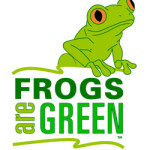Tomato frog (D. antongilli)
This frog is definitely NOT green! Colored as red a ketchup, the Tomato frog’s bright color is meant to warn predators that it is not safe to eat. The frogs secrete a gummy substance that gets in a predator’s eyes so it will drop the frog, which can then make a quick escape. The Tomato frog is found only in Madagascar.
Glass frogs (family, centrolenidae)
Glass frogs are nocturnal tree frogs that live in the humid forests of Central and South America. Their name comes from the translucent skin on the underside of their bodies. In many species the glass frogs’ internal organs, even a beating heart, can be seen. This see-through skin helps them blend into the forest.
Ornate horned frog (Ceratophrys ornata)
This frog is nicknamed the Pac-Man frog because of its enormous mouth and insatiable appetite. They are a sit-and-wait ambush predator and hide well-disguised on the ground or in leaf litter. Ornate horned frogs can swallow birds, insects, mice, or even other frogs whole. This species can be found in Uruguay, Argentina, and Brazil.
Turtle frog (Myobattachus gouldii)
This unusual-looking frog looks like a turtle that has lost its shell. It has a short, blunt snout, little beady eyes, and short, fat limbs. It lives underground in burrows in sandy soil and chambers in termite colonies, upon which it feeds. During a few rainy nights in summer they emerge, mate, then then burrow underground where the eggs are laid. Four to six months later the eggs hatch as fully formed froglets. The Turtle frog only lives in the coastal plains and woodlands of extreme Southwestern Australia.
Wallace’s Flying Frog (Rhacophorus nigropalmatus)
Water-holding frog (Cyclorana platycephala)
Unusual among frogs, water-holding frogs can catch prey—aquatic insects and small fish—underwater, lunging at the animals and stuffing them in their mouths with their arms. During the dry season they become inactive and burrow underground, secreting a mucous to line their burrows. This hardens around the body and enables the frog to retain water that might otherwise be lost due to evaporation. These frogs were traditionally used by indigenous people in Australia as a source of water. They would dig up the frogs, gently squeeze the water from them, and release them unharmed. Water-holding frogs live in grasslands, temporary swamps, and clay pans in arid areas of southern Australia.
Pinocchio-nose frog (no scientific name yet)
The Pinocchio-nosed frog was discovered recently during a wildlife expedition to Indonesia’s remote Foja Mountains. This long-nosed frog, a tree frog, has a spike on its nose that points upward when the male is calling but deflates and points downward when he is less active. You can see the Pinocchio-frog and the other newly discovered species on the National Geographic site.
The hip pocket frog (Assa darlingtoni)
This is called a Male Marsupial frog because like a kangaroo it carries its young in pouches. It has two openings, one on each hip, where tadpoles develop. First the female lays eggs in damp sand, then they are guarded by the male, and finally they hatch into finless white tadpoles, which wriggle their way into the pouches. Only about half make it. They emerge 7 to 10 weeks later as froglets. Hip-pocket frogs are terrestrial and live among leaf litter in the forest (and like a few of our other unusual frogs, they are only found in Australia).
Southern gastric-brooding frog (Rheobatrachus silus)
This species was discovered in 1972 living in rocky creeks and ponds in the rainforest of Queensland, Australia. They have an amazing way of “bringing up baby.” First the female swallows her eggs, then her digestion slows down and she stops feeding and the tadpole develops in her stomach. After six to eight weeks, she opens her mouth, dilates her esophagus and the babies crawl out. Sadly, this extraordinary frog is most probably extinct. The last wild southern gastric-brooding frog was seen in 1981—the last known frog in captivity died in 1983.
Pipa or Surinam Toad (Pipa pipa)
This Surinam toad is the world’s flattest amphibian—in fact, it looks like the victim of an unfortunate road accident. Yet this frog’s unusual shape helps hide it among the leaves and plant debris in the streams they inhabit in the Amazon River Basin of South America. Like some of the other frogs above, they have an amazing reproductive strategy: after the female lays eggs the male attaches them to the female’s back. They stick to her skin, which grows to form pockets over them, giving her a honeycomb appearance. The tadpoles grow within these pockets and emerge as toadlets after 20 weeks.
_______________________________________________
We’ve designed a cool new 2011 calendar and poster: The Weirdest and Most Unusual Frogs on Earth. Get one for your kid’s room!
Note: I got most of the information for this post from The Golden Guide to Frogs and Toads:















Pingback: Penguin Blog
Pingback: 10 Frogs Handsome Enough to Kiss « Frogs Are Green- A blog to raise awareness about the threats frogs face in the world's changing environment. A frog conservation company helping to save frogs from extinction.
Pingback: The 10 Weirdest and Most Unusual Frogs on Earth | The Wandering Herpetologist
You have a way with words. I am adding this page as a bookmark on Digg.com so all my friends can see it. I think they will like it as much as I did. If they do, then I will add a link to one of my Hubpages with your anchor text or something very similar. All the best with future posts, good work.
This is really interesting, You’re a very skilled blogger. I’ve joined your
feed and look forward to seeking more of your fantastic post.
Also, I have shared your web site in my social networks!
Can you identify this toad? We live in the Mpls,MN. area. He sat on our light all day, but was gone the next morning. I have a photo, but don’t know how to attach. He looks like the head of a rattle snake! Thanks! Jay 952-457-2104
Jay, Email your photo to info@frogsaregreen.com and we’ll see if we can identify the toad near you. – Susan